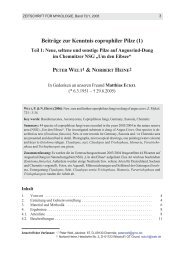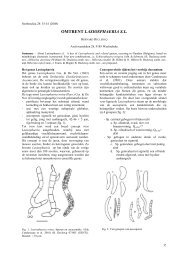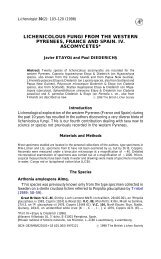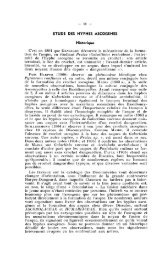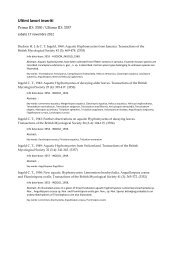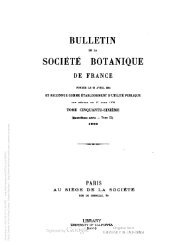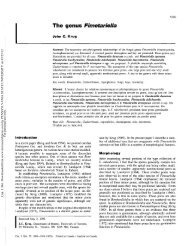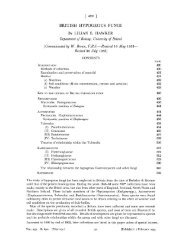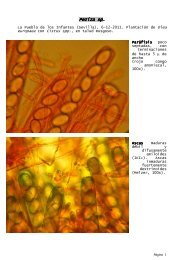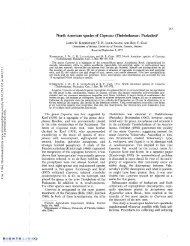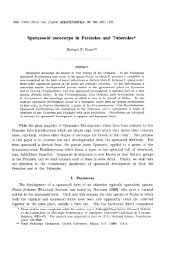NITSCHKIA BROOMEANA - ASCOfrance
NITSCHKIA BROOMEANA - ASCOfrance
NITSCHKIA BROOMEANA - ASCOfrance
You also want an ePaper? Increase the reach of your titles
YUMPU automatically turns print PDFs into web optimized ePapers that Google loves.
Mangifera indica; Mimusops hexandra (stem); Morus rubra, Morus sp.; Myrica sp.; Nyssa sylvatica;<br />
Oogeinia oogeinensis (stem); Persea americana; Pinus strobus, P. sylvestris (cone), P. taeda, Pinus sp.;<br />
Pongamia glabra; Prunus sp.; Pyrus communis, P. malus; Quercus sp.; Rhamnus sp.; Robinia<br />
pseudacacia; Rubus sp.; Salix koreensis, S. nigra; Sambucus canadensis; Sassafras sp.; Schizolobium sp.;<br />
Shorea robusta (stem, wood); Sophora japonica; Tectona grandis (root); Tilia heterophylla var.<br />
michauxii; Ulmus alata; Viburnum grandiflorum, Viburnum sp.; Weinmannia sp. Other associated<br />
organisms: Fungi: Botryosphaeria ribis.<br />
GEOGRAPHICAL DISTRIBUTION: AFRICA: Gambia, Ghana, Malawi, Sierra Leone, Zimbabwe. NORTH<br />
AMERICA: USA (Alabama, Florida, Georgia, Idaho, Louisiana, Nebraska, New Jersey, North Carolina,<br />
Ohio, Oklahoma, South Carolina, Tennessee, Virginia). CENTRAL AMERICA: Guatemala, Nicaragua,<br />
Panama. SOUTH AMERICA: Argentina, Brazil, Venezuela. ASIA: China (Beijing, Fujian, Hebei, Hunan,<br />
Jiangsu, Sichuan, Yunnan, Zheijang), India (Andhra Pradesh, Chhattisgarh, Madhya Pradesh,<br />
Maharashtra), Japan, Korea, Pakistan, Sri Lanka, Taiwan. AUSTRALASIA: Australia (South Australia),<br />
New Zealand. EUROPE: former Czechoslovakia, France, Great Britain, Italy, former Yugoslavia.<br />
INFRASPECIFIC VARIATION: The large number of synonyms, many of which are subspecific in rank,<br />
suggests that there may be some infraspecific variation in this fungus. Slightly larger ascospores have<br />
been observed, for example, in collections from northwest Scotland, than in collections from lower<br />
latitudes.<br />
TRANSMISSION: Ascomata of this species open by irregular apical cracks, but the mode of ascospore release<br />
and transmission is not known.<br />
NOTES: Diagnostic features. Clusters of ascomata ornamented with short spines emerging from bark or<br />
superficial on woody substrata; asci each containing more than 200 ascospores usually arranged in a<br />
characteristic ‘herringbone’ pattern.<br />
NANNFELDT (1975) regarded this species as ‘widespread in most warmer countries’ but thought that in<br />
Europe records ‘from more northern areas are erroneous’. While this may be generally true, several<br />
specimens have been collected on fallen cones of Pinus sylvestris in native woodland in Scotland, but<br />
only in the northwest, where the mild climate and infrequent frosts as a result of the Gulf Stream may be<br />
a significant factor. There, the fungus is never abundant and only very occasionally encountered, but<br />
appears to be native.<br />
Interactions. None reported. Probably saprobic or, like other members of this genus, parasitic on other<br />
fungi.<br />
Conservation status. Records exist from at least 1854 to November 2001, and the species has been<br />
observed from January–June and August–December. In addition to cited literature and internet sources,<br />
this description sheet is based on 19 items in the IMI dried reference collection, 18 records in the<br />
author’s computerized database (11 of which refer to IMI items), 4 records in the Fungal Records<br />
Database for the British Isles (http://194.203.77.76/fieldmycology/), 62 records in the USDA database<br />
(http://nt.ars-grin.gov/fungaldatabases/index.cfm) and 4 specimens in the K fungal reference collection.<br />
This fungus is very widely distributed and rather frequently encountered. The absence of recent records<br />
may be more a reflexion on the decline of field mycologists than an indication of a change in population<br />
status. The species is associated with many different and unrelated plants, many undoubtedly not at risk,<br />
although they may not be the nutrient source if N. broomeana is indeed parasitic on other fungi. There are<br />
no obvious threats. Using IUCN criteria [IUCN SPECIES SURVIVAL COMMISSION (2006). 2006 IUCN Red<br />
List of Threatened Species. . Downloaded on 15 May 2006], the species is<br />
assessed globally as least concern.<br />
LITERATURE: CHEN, C.Y. & HSIEH, W.H. New records of ascomycete for Taiwan. Transactions of the<br />
Mycological Society of the Republic of China 9(1): 1–20 (1994). Chen, M.M. Forest Fungi<br />
Phytogeography Forest Fungi Phytogeography of China, North America, and Siberia and International



